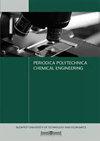Effect of Fe Addition on Anaerobic Digestion Process in Treating Vinasse: Experimental and Kinetic Studies
IF 1.8
4区 工程技术
Q3 ENGINEERING, CHEMICAL
引用次数: 2
Abstract
Vinasse is a continuously resulting waste by a bioethanol industry with a high chemical oxygen demand (COD) concentration and a large volume. Anaerobic digestion (AD) is the best method to treat vinasse because it converts COD to biogas, so the biogas can support the Indonesia's primary energy need. The goal of this study was to study the effect of Fe concentration on the AD process in treating the vinasse. The Fe concentration was varied to 0.06, 0.29, 0.64, 0.99 g/L. The results showed that increasing the Fe concentration from 0.06 to 0.29 g/L intensified the biogas yield by 360% (from 10.8 to 49.6 mL/g COD). However, further increasing the Fe concentration to 0.99 g/L decreased the biogas yield by 37.8% (from 10.8 to 6.7 mL/g COD). The Fe significantly affected the methane formation stage, but not the acid formation stage. A mechanistic model was built and successfully applied to predict the AD process. Based on the simulation results, Fe concentration of 0.29 g/L resulted in the highest values of YVFA/X2 (yield of volatile fatty acids (VFAs) consumption per biomass of X2 ), μm,2 (specific growth rate for X2 ), fCH4 (composition of methane in biogas) and the lowest values of Ks,VFA (affinity coefficient in VFAs consumption), kd2 (death rate constant for X2 ), kVFA (consumption rate of VFAs for maintenance). The addition of Fe until 0.29 g/L was recommended to increase the quantity and quality (methane content reached 53.4%) of biogas production.添加铁对处理酒渣厌氧消化过程的影响:实验与动力学研究
酒糟是生物乙醇工业连续产生的化学需氧量(COD)浓度高、体积大的废弃物。厌氧消化(AD)是处理酒糟的最佳方法,因为它将COD转化为沼气,因此沼气可以满足印度尼西亚的一次能源需求。本研究的目的是研究铁浓度对处理酒糟AD过程的影响。Fe浓度分别为0.06、0.29、0.64、0.99 g/L。结果表明,当Fe浓度从0.06 g/L增加到0.29 g/L时,沼气产量提高了360% (COD从10.8 mL/g提高到49.6 mL/g)。然而,当铁浓度进一步增加到0.99 g/L时,沼气产量下降了37.8%(从10.8 mL/g COD降至6.7 mL/g COD)。铁对甲烷形成阶段的影响显著,而对酸形成阶段的影响不显著。建立了一个机制模型,并成功地应用于AD过程的预测。模拟结果表明,当Fe浓度为0.29 g/L时,每生物量消耗的挥发性脂肪酸(VFAs)产率(YVFA/X2)、特定生长率(μm,2)、甲烷组成(fCH4)值最高,而挥发性脂肪酸消耗亲和系数(VFA)、死亡率常数(kd2)、维持用挥发性脂肪酸消耗速率(kVFA)值最低。建议添加铁至0.29 g/L,可提高沼气产量和质量(甲烷含量达53.4%)。
本文章由计算机程序翻译,如有差异,请以英文原文为准。
求助全文
约1分钟内获得全文
求助全文
来源期刊

Periodica Polytechnica Chemical Engineering
ENGINEERING, CHEMICAL-
CiteScore
3.10
自引率
7.70%
发文量
44
审稿时长
>12 weeks
期刊介绍:
The main scope of the journal is to publish original research articles in the wide field of chemical engineering including environmental and bioengineering.
 求助内容:
求助内容: 应助结果提醒方式:
应助结果提醒方式:


